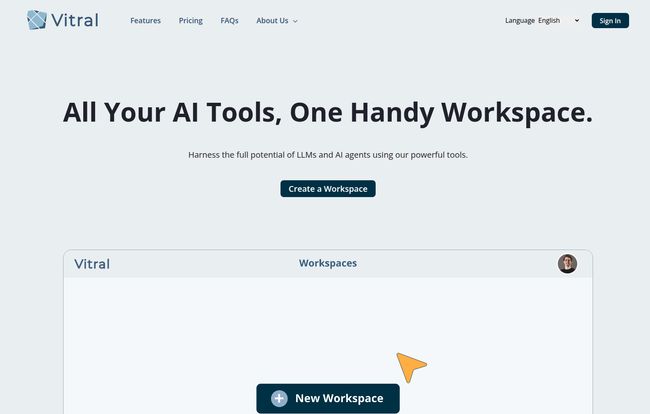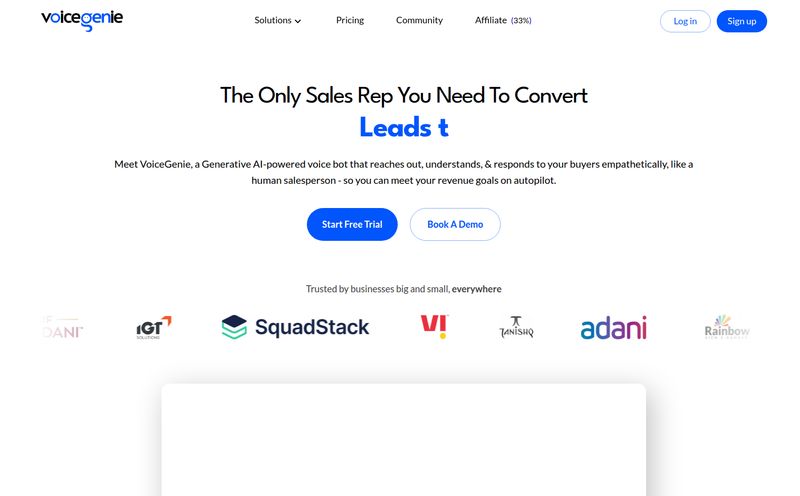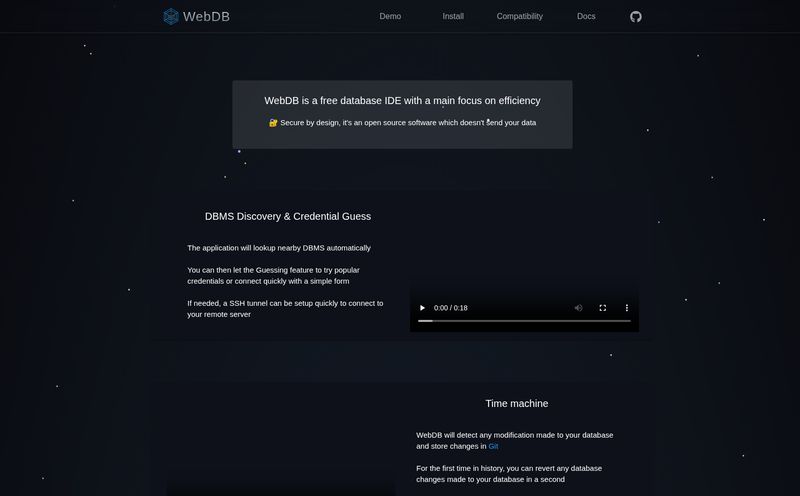If your screen looks anything like mine most days, it's a chaotic battlefield of browser tabs. I've got a tab for ChatGPT for drafting, one for Claude for analysis, another for Gemini for brainstorming, and probably a rogue image generator somewhere in the mix. Each has its own history, its own context, and switching between them feels like a mental whiplash. It’s messy. It’s inefficient. And frankly, it's driving me a little nuts.
For months, I've been saying that someone needs to create a proper workbench for all these powerful tools, not just another thin wrapper. A place where they can all live and, more importantly, work together. Well, I think I might have just found it. It’s called Vitral, and it’s not just another app—it’s a whole new environment.

Visit Vitral
So, What is Vitral, Anyway?
On the surface, Vitral bills itself as an "AI-integrated workspace hub." But that's corporate-speak. What does it actually feel like? In my experience, it’s less like a cluttered toolbox and more like a custom-built, modular workbench. You know, the kind where every screwdriver, wrench, and doodad has its own perfectly cut foam slot. It’s designed to bring all your LLMs and AI agents into one space where they can collaborate with you on projects through notebooks, code editors, and live samples.
The core idea that got me hooked is the concept of flexible, isolated workspaces. Instead of one long, confusing chat history with an AI, you spin up a new, clean workspace for each task. Writing a blog post? New workspace. Analyzing CPC data? New workspace. Debugging some Python script? You get the idea. This prevents context bleed-over and keeps you incredibly focused. Its a simple concept, but the execution is what makes it so powerful.
The Standout Features That Genuinely Impressed Me
A platform is only as good as its tools, and Vitral comes packed with some genuinely thoughtful features. It's not just a chat window with a dropdown to switch models.
More Than Just a Chatbot
The conversation interface itself is a big step up. You get proper markdown and code formatting, which is a godsend. But the real magic is in the multimodal capabilities. Vitral has an AI-powered visual recognition tool built right in. You can drop an image into your workspace and ask the AI questions about it. For someone who works with a lot of data visualizations and infographics, this is a massive time-saver.
Then there are the "Live Samples." This lets you create and manage examples or snippets that the AI can reference and work with directly. It's an active, collaborative process, not just a passive Q&A session.
Meet Your Custom AI Crew
This is where it gets interesting. Vitral comes with its own team of custom AI agents, each with a specific purpose. You've got:
- Mnemodia: The memory specialist. This agent is designed for advanced search and indexing your data. It helps you find anything across your workspaces.
- Iris: The visual expert. This is the agent powering that visual recognition feature I mentioned.
- Carlo: The task orchestrator. This agent helps manage workflows and complex operations.
Having specialized agents feels like having a small, dedicated AI team on standby. It’s a smart way to handle different aspects of a project without overloading a single generalist model.
A Coder's Dream Setup? Pretty Close.
While I'm more of an SEO and content guy, I do dabble in code for scripts and site analysis. Vitral seems to have been built with developers in mind. It has a fully integrated code editor and an interactive web-based terminal. The ability to write, test, and debug code with an AI assistant in the same window without context switching is huge. It also supports a ton of different LLMs (OpenAI, Anthropic, Llama, Mistral, Gemini), so you can pick the best model for your specific coding challenge.
Let's Talk Money: The Vitral Pricing Model
Alright, this is the part that always makes me nervous with new platforms: the cost. Vitral uses a pay-as-you-go credit system, which can be a double-edged sword. On one hand, you only pay for what you actually use, which I love. On the other hand, it can feel unpredictable if you're not careful. But Vitral has been pretty transparent about it.
The costs are broken down into three main parts:
- Token Consumption: This is the main cost. Every time you interact with an LLM, you use tokens. The price varies depending on the model you choose. For instance, using OpenAI's GPT-3.5 is much cheaper than using Claude 3 Opus. This flexibility is great because you can use a cheaper model for simple tasks and save the expensive, powerful ones for when you really need them.
- Storage: You get a free 25GB of storage for your workspaces, files, and conversations. For most people, myself included, that's a ton of space. If you're a super heavy user, you'll pay for storage beyond that, but the fee is reasonable.
- Compute Instances: This is more for the developer crowd. The platform runs on AI-managed compute instances, and there are free tier limits. If you need a permanent, always-on instance for a deployed application, that's when you'll start seeing charges here.
Here’s a quick look at some of the token prices to give you an idea. The costs are per 1,000 tokens (Input is what you send, Output is what the AI sends back).
| Provider | Model | Input Cost / 1k tokens | Output Cost / 1k tokens |
|---|---|---|---|
| OpenAI | GPT 3.5 Turbo | $0.00060 | $0.01200 |
| Gemini 1.0 Pro | $0.00010 | $0.00300 | |
| Anthropic | Claude 3 Sonnet | $0.00060 | $0.00300 |
Note: This is just a sample. Check the official Vitral pricing page for the full, up-to-date list.
The Good, The Bad, and The... Under Construction
No tool is perfect. After playing around with Vitral, here's my honest take. The good is really good: the flexibility is off the charts, and the integration of multiple tools into one cohesive workspace is exactly what the market needs. Renny Castañeda, the CEO of Poliversia, put it well: "Vitral gives me the flexibility to set up my workspace exactly how I need it... what really stands out is how everything works together." I have to agree with that sentiment.
On the flip side, the pay-as-you-go model, while fair, will require some users to be mindful of their consumption. If you're running massive data analyses on GPT-4o all day, the bill could creep up. The other minor quirk? Their "About Us" section is currently under construction. It's a tiny thing, but it does make them feel like a newer company still getting its feet wet. It's not a dealbreaker, just a little amusing.
So Who is Vitral Actually For?
This isn't just a tool for hardcore developers. I see a few key groups getting a ton of value here:
- Developers & Data Scientists: This is a no-brainer. The integrated code editor, terminal, and compute instances make it a powerful dev environment.
- Content Creators & SEOs: Like me! Managing multiple research threads, drafting articles, analyzing SERP data, and creating content briefs in separate, focused workspaces is a game-changer for organization and productivity.
- Researchers & Academics: The ability to upload documents, use visual recognition on charts, and keep extensive notes alongside AI conversations is perfect for deep research projects.
- Agency Owners: Managing different client projects in isolated workspaces? Yes please. This could seriously streamline agency workflows.
My Final Thoughts on Vitral
I've seen a lot of AI tools come and go. Most are just hype. But Vitral feels different. It feels substantial. It's built on a smart premise: that the future of work isn't about finding one perfect AI, but about creating the perfect environment for all of them to work together. It successfully tames the chaos of the multi-LLM world we now live in.
It's not for the casual user who just wants to ask an AI for a dinner recipe. It's for professionals who use these tools as a core part of their daily work. If that's you, I think you owe it to yourself to spin up a workspace and give it a try. It might just be the thing that finally cleans up your browser tabs.
Frequently Asked Questions
- Is Vitral a free tool?
- Vitral operates on a freemium model. You get a generous free tier that includes 25GB of storage and a certain amount of free compute usage. You only pay for the LLM tokens you use and for any storage or compute that exceeds the free limits.
- Which AI models can I use with Vitral?
- You get a wide selection! Vitral supports models from major providers including OpenAI (like GPT-3.5, GPT-4), Google (Gemini models), Anthropic (the Claude 3 family), Meta (Llama models), and Mistral.
- How does the pay-as-you-go credit system work?
- You purchase credits for your account, and these credits are used to pay for your token consumption. The credits never expire. Each time you interact with an AI, the system calculates the token cost based on the specific model you used and deducts it from your credit balance.
- Is Vitral useful for people who aren't developers?
- Absolutely. While it has powerful tools for coders, its core benefit is organization and workflow management. Writers, researchers, marketers, and project managers can benefit immensely from the isolated workspaces and integrated note-taking and data analysis features.
- What makes Vitral different from just using the ChatGPT website?
- The key difference is the environment. ChatGPT is a single tool. Vitral is a workbench that holds many tools. It allows you to use multiple AIs, integrate them with a code editor, a file system, and visual analysis tools, and keep every project separate and organized in its own workspace.



